Intro to Insects
Insects comprise the largest number of terrestrial animals on the planet. According to the Encyclopedia Smithsonian, there are 91,000 described species with 10 quintrillion (10,000,000,000,000,000,000) individuals alive on Earth!
With this many insects, it is no wonder that they play an important role in Earth’s ecosystem. Insects can be pests, competing with humans for resources, such as crops; yet other species, such as bees, wasps, and butterflies, are important pollinators of these same crops. Insects also are beneficial to us as biological control agents, killing or parasitizing pest insects; recycling decaying organic matter, including feces and carcasses; and serving as a primary food source in some countries. Insects can also be important medically…they can be used in maggot therapy to heal wounds or venom therapy, yet they can be vectors of serious diseases, such as Chagas, sleeping sickness, or malaria.
With so many interactions between mankind and insects, both negative and positive, these creatures deserve our respect. They may be small, but their impact on human interests can hardly be measured. This publication will provide information about using insects as educational tools as well as discuss the background, basic biology, and classification of insects. Then, in Appendix A, complete lesson plans are available for instructors to use in elementary classrooms or educational programs to teach children about the importance of these small creatures.
Teaching with Insects
Because of the large diversity of insects, they can be used in many valuable ways in an educational setting. In addition to scientific topics, they can be used, through their appearance in many books and films, to teach moral lessons, basic life skills, and how insects are viewed in society.
Insects are abundant, easy to obtain, and fairly inexpensive to rear and maintain. Most just require a small to medium sized terrarium with some bedding, water, and food. If properly cleaned and taken care of, insects can often survive for several generations (eggs hatch, go through their life cycle, mate, and lay more eggs) when you have a breeding population. See Appendix B for a list of the types of insects you can rear in your classroom.
When teaching scientific concepts, educators should include Next Generation Science Standards in their curriculum. To help guide educators, lesson plans included in Appendix A will list in depth which standards each particular activity addresses. This includes the main content standard, science and engineering practices, disciplinary core ideas, and crosscutting concepts. See Table 1 for an example of Next Generation Science standards that might be covered in insect related curriculum.
Before developing and conducting your own educational program, you should have a good understanding about the biology and classification of insects, which you will want to discuss in your lessons. Let’s begin by giving a basic overview about insects and their roles in the environment.
Table 1: Example of Next Generation Science Standards Used in Insect Curriculum
| Next Generation Science Standards:
Interdependent Relationships in Ecosystems: Animals, Plants, and Their Environment
Students who demonstrate understanding can:
K-LS1-1. Use observations to describe patterns of what plants and animals (including humans) need to survive.
K-ESS3-1. Use a model to represent the relationship between the needs of different plants and animals (including humans) and the places they live. |
Insect Classification
As with other living organisms, insects are placed in a hierarchical scientific classification structure:
Kingdom
Phylum
Class
Order
Family
Genus
Species
The diversity of insects is astounding, which becomes more apparent the narrower we go in the classification system. At its basic level, insects belong to the Kingdom Animalia, so in this they are related to mammals, birds, or amoebas. However, Phylum Arthropoda reduces their commonality with most other animals significantly.
Arthropods have distinct characteristics that assign them to this phylum. The three main ones include having an exoskeleton (hard shell on the outside of the body, as opposed to internal skeleton, as humans and many other animals have); segmented body; and jointed appendages. Insects do share these traits with some other common animals, such as crustaceans (lobsters and shrimp), millipedes, centipedes, and spiders. This brings us to the next level: Class.
Insects belong, not surprisingly, to Class Insecta. This is where they diverge from related arthropods like spiders. Insects, for example, have three distinct body regions: a head, thorax, and abdomen. They also have six legs, arising from the middle body segment, or thorax, and a pair of antennae. Compare this to arthropods such as spiders (Class Arachnida), which have two body segments, eight legs, and no antennae, or millipedes (Class Diplopoda), which have numerous body segments, with a pair of legs on each segment.
The next classification level is Order. Here is where diversity is readily obvious. There are approximately 30 orders in Class Insecta (Figure 2). Some variation exists where scientists have proposed new or adapted orders to accommodate insects currently featured in their own orders but that share certain characteristics with other species (such as combining termites and cockroaches together where previously they were separated). Below is the current consensus for accepted Insect Orders.
Figure 2: Insect Orders
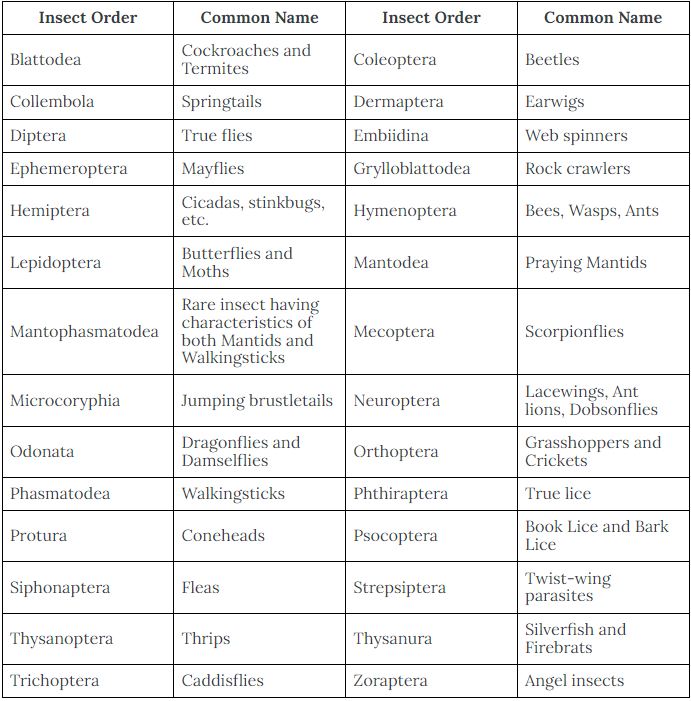 Of the insect orders, some of the more common include Blattodea, Coleoptera, Diptera, Hemiptera, Hymenoptera, Lepidoptera, Mantodea, Neuoptera, Orthoptera, Odonata, Pthiraptera, and Siphonaptera.
Of the insect orders, some of the more common include Blattodea, Coleoptera, Diptera, Hemiptera, Hymenoptera, Lepidoptera, Mantodea, Neuoptera, Orthoptera, Odonata, Pthiraptera, and Siphonaptera.
For the rest of the classification, family, genus, and species further narrows down an individual type of insect. For example, the full classification of a honeybee would be as follows:
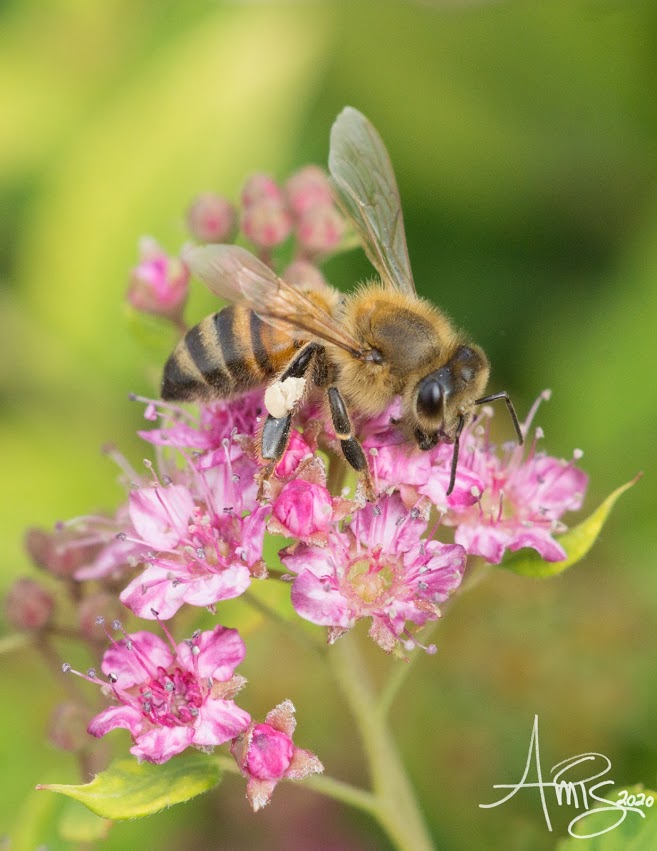
Kingdom: Animalia
Phylum: Arthropoda
Class: Insecta
Order: Hymenoptera
Family: Apidae
Genus: Apis
Species: mellifera
The genus and species together make up the scientific name for an organism. For the honeybee, it would be listed as Apis mellifera (genus capitalized, species lower-case, and always in italics). “Honeybee” is known as the common name.
Another example:
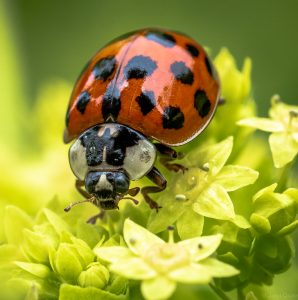
Common name: Multicolored Asian Lady Beetle
Scientific name: Harmonia axyridis
Classification
Kingdom: Animalia
Phylum: Arthropoda
Class: Insecta
Order: Coleoptera
Family: Coccinellidae
Genus: Harmonia
Species: axyridis
Please be aware that classifcations can become more complex with subphylums, suborders, superfamilies, and subfamilies, but in general, all organisms follow the classification system listed here.
Insect Basics
Now that we’ve discussed how insects fit into the hierarchy of living things, let’s take a closer look at the insect body itself…how it works and what makes it unique.
Insect Life Cycles
Insects undergo a life cycle called metamorphosis that is rather unusual within the animal kingdom. All insects hatch from an egg (mostly outside the body, but sometimes within the mother before being laid as live young!), then in their immature forms, grow in stages, known as instars. In order to reach the next instar, they must undergo a process called molting, where they shed their old exoskeleton and replace it with a new, larger one.
Insects experience one of four types of life cycle, depending upon the Order:
“No” metamorphosis (Ametabolous):
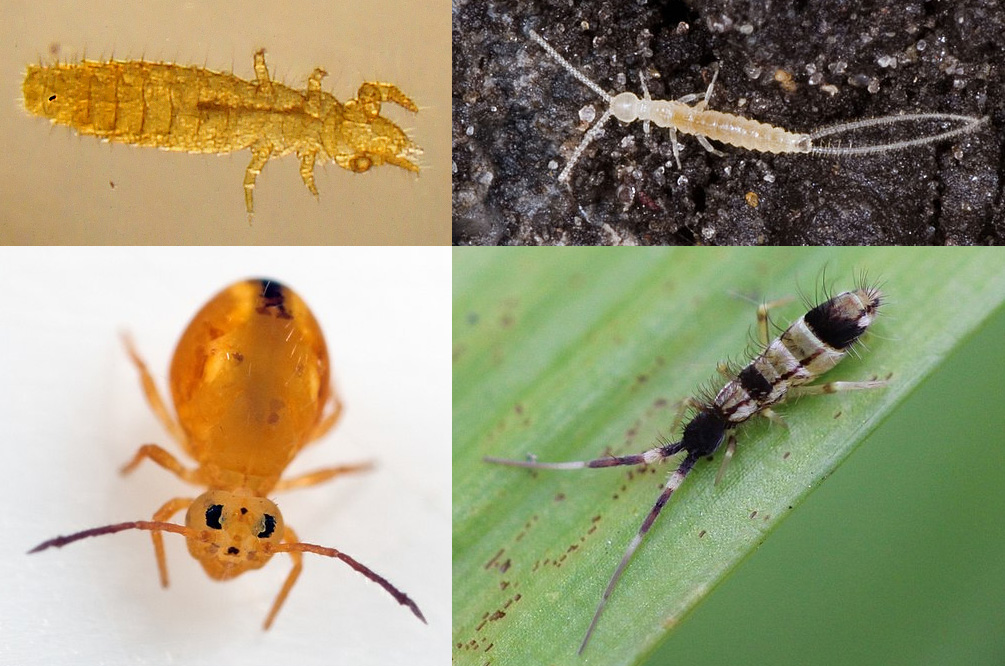
This is found in the more primitive insects, such as silverfish. In this case, there is an egg, an immature, and an adult. The young look like the adult, only smaller, and eat the same foods. The adults are wingless and sexually mature.
Example of Orders with this type: Collembola, Thysanura, Phthiroptera
Gradual metamorphosis (Hemimetabolis):
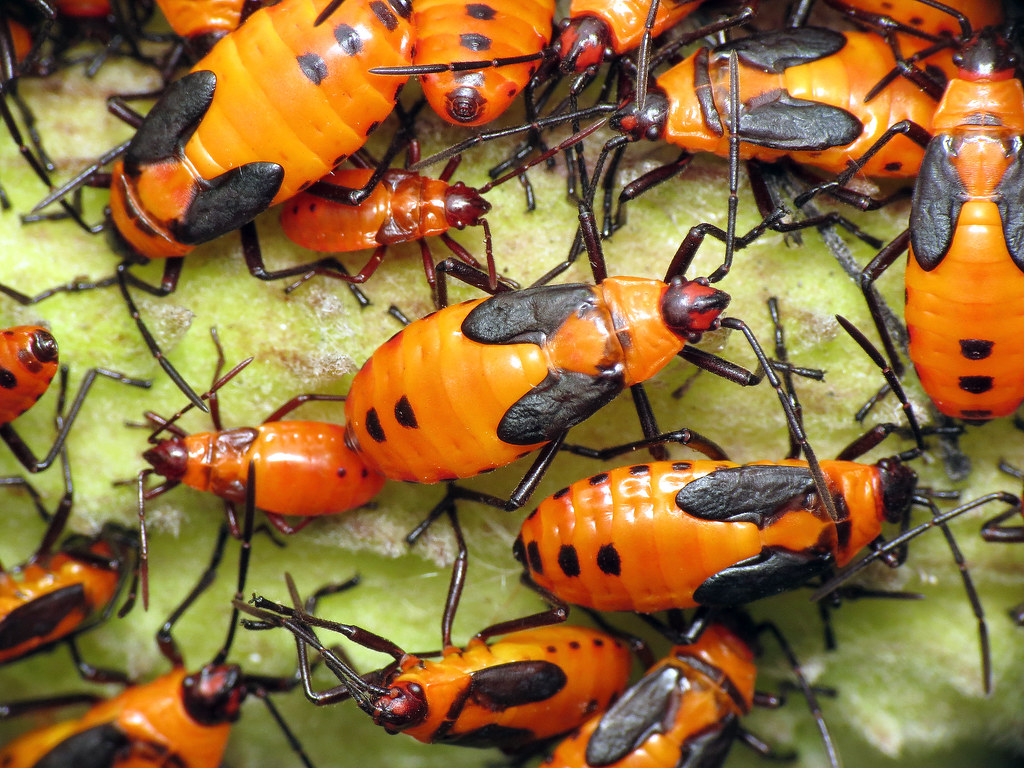
This life cycle includes an egg, a nymph, and an adult. The nymph looks just like the adult only smaller, and eats the same foods. The difference between gradual and no metamorphosis is that nymphs have wing pads that grow with each molt and are fully formed in adulthood. Only adults are sexually mature.
Examples of Orders with this type: Orthoptera, Psocoptera, Thysanoptera, Hemiptera, Dermaptera, Blattodea
Incomplete metamorphosis (Hemimetabolis):
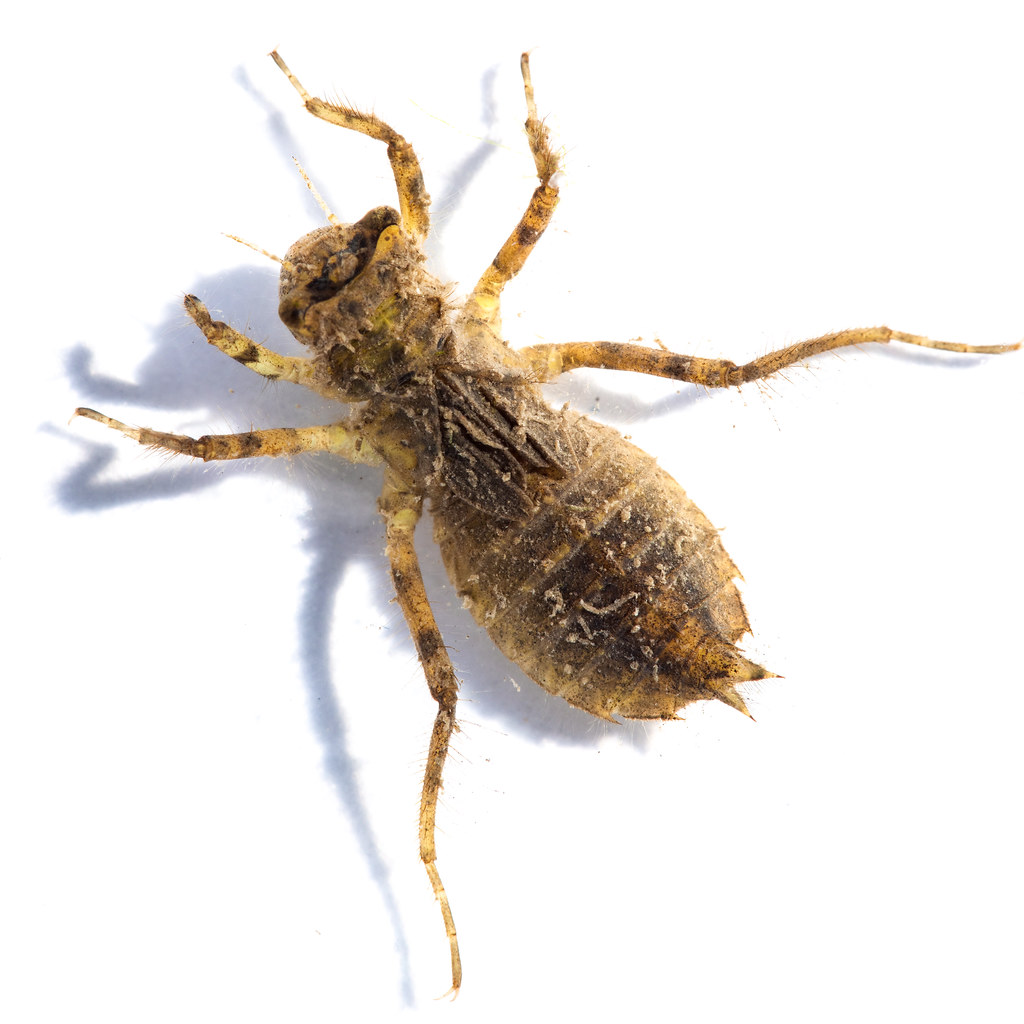
This special type of gradual metamorphosis is found only in insects that spend part of their development in water. Here, they have an egg, a naiad (similar to a terrestrial nymph), and adult. Naiads are usually predatory, feeding on smaller aquatic organisms, while the adults are flying terrestrial insects. Dragonflies are commonly seen hovering around ponds, which is where they lay eggs and “grow up.”
Examples of Orders with this type: Ephemeroptera, Odonata, Plecoptera
Complete metamorphosis (Holometabolis):

This is the life cycle most often seen in insects. Insects with complete metamorphosis have four stages: egg, larva, pupa, and adult. In this case, “baby” insects look and feed differently from adults. One of the more well-known examples is the butterfly. The larva, or caterpillar, is a worm like creature that chews on leaves, then spins a cocoon, chrysalis, or pupal case, where it rests and changes form completely. It emerges as a winged butterfly that siphons up nectar from flowers, very different from its larval form, where it chewed on leaves. Although the larva and adult look different, one of the biggest changes is that the young do not have wings and the adults do.
Examples of Orders with this type: Neuroptera, Coleoptera, Mecoptera, Trichoptera, Lepidoptera, Diptera, Siphonaptera, Hymenoptera
Insect Body parts
In addition to the different life cycles, insects also vary in their basic body parts. Although the structure is the same for all insects (three body segments, six legs, antennae, and in most cases, wings), there are numerous variations depending on lifestyle. For example, an insect that eats leaves requires completely different mouthparts than an insect that sucks blood. Here are some of the different kinds of insect body parts:
Antennae: filiform (individual segments, similar size), setaceous (many joints, tapers at end), moniliform (looks like string of beads), serrate (angled on one side), pectinate (segments longer on one side), clavate (segments get wider toward the tip), lamellate (segments at end flat and fan like), geniculate (bend in antenna), plumose (feather like)
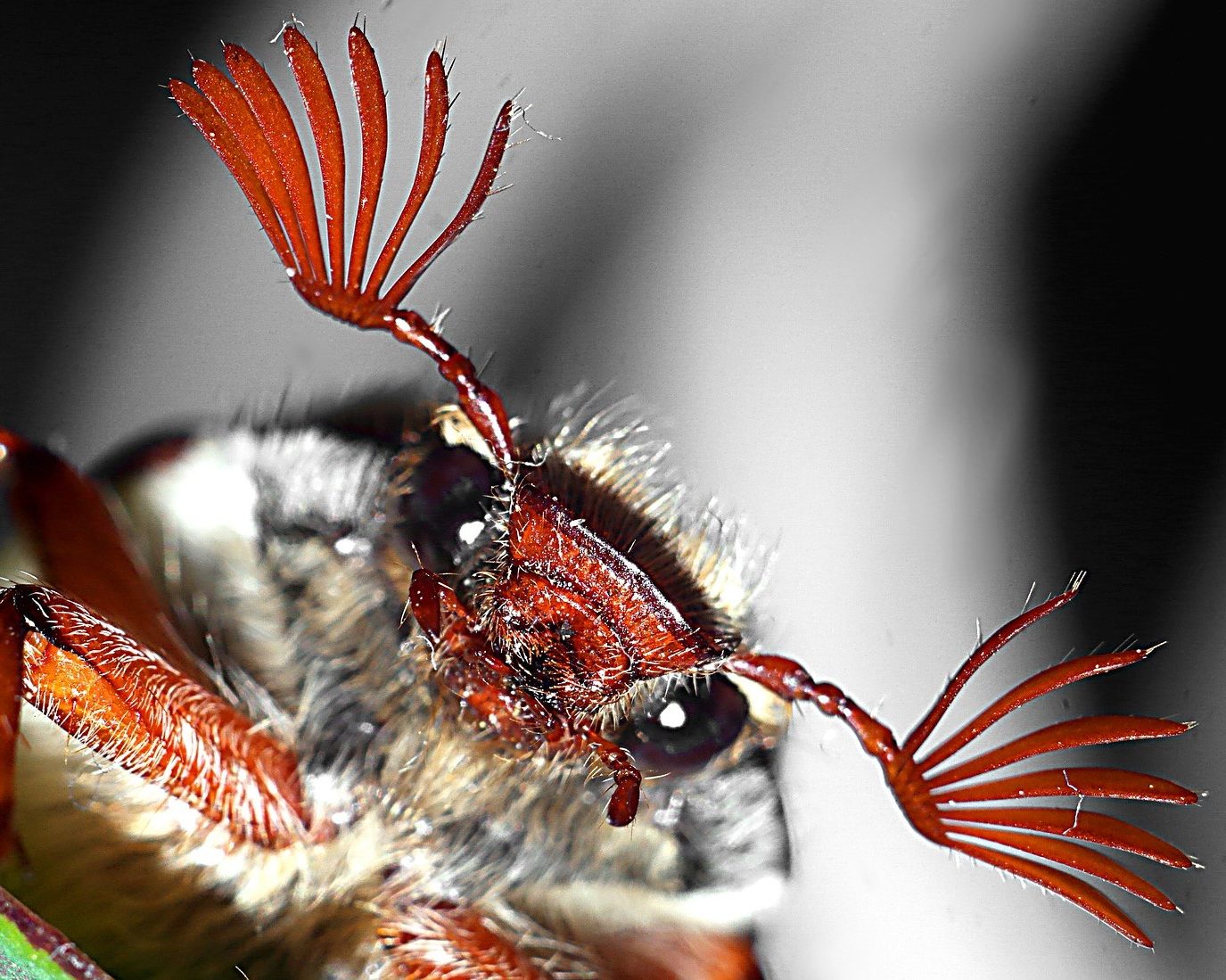
Legs: Cursorial (running), raptorial (grasping), saltatorial (jumping), natatorial (swimming), fossorial (digging)
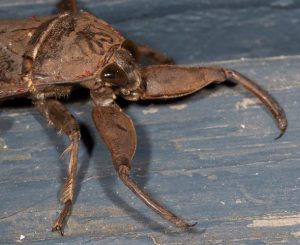
Wings: Tegmina (leathery), membranous, Elytra (hard)

Mouthparts: Chewing, piercing-sucking, rasping, siphoning, sponging/lapping
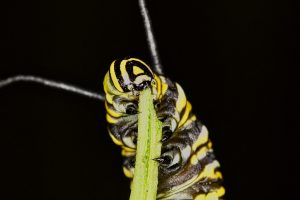
Insect Reproduction
Most insects, like other animals, sexually reproduce. After emerging as adults, mating is usually the main objective as many adult insects do not live very long. Males must find females and females lay their eggs before they die. Some species, however, do reproduce asexually, or through parthenogenesis. In this latter case, only females are produced and they are able to lay eggs (or in the case of some insects like aphids, “give birth” to nymphs), which are essentially clones of their mothers.
Common reproduction strategies include “r” and “K” selected species. “r” strategists are interested in quantity over quality…they have a large number of offspring and little parental care. This strategy is followed by insects that have short life spans and want to ensure that at least some of their young survive to adulthood. Examples include aphids and mayflies. “K” strategists are longer lived and put in some parental care, thus having fewer offspring. These include tsetse flies and bat flies.
Another interesting aspect of insect reproduction involves birth itself. Although most insects lay eggs, sometimes protected but usually near a host plant or within or near prey, a few insects give live “birth” to larvae, such is the case with tsetse flies. In these cases, the egg hatches within the mother and she sustains it until it grows to a size where it is more likely to survive. This is more seen in K strategists, but aphids do give birth to nymphs, although they provide no follow up care.
References and Resources
Encyclopedia Smithsonian
NGSS Lead States. 2013. Next Generation Science Standards: For States, By States. Washington, DC: The National Academies Press.

